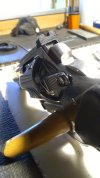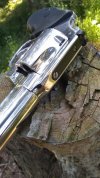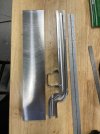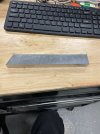It would have taken several setups even with a mill to do all the features. Leaving a handle on a part and then cutting it off as one of the last steps is a good technique. We do something similar on a couple things we make. The only down side is the waste of some material but that's usually small cost compared to the cost of labor, extra setups, etc to be too frugal. Right now I'm sitting here tending our CNC mill making an item where the end product weighs 1/6 of the starting billet. 5/6 is turned into chips and waste. It's all handle!
A friend of mine has two MFA degrees, one in blacksmithing. We've sat and discussed various topics. Prior to the use of powered metal removal tools (mills, lathes, shapers, etc) it was often easier to move metal from place to place instead of removing metal. The last steps may require some material removal but the first steps displace metal.
Keith, THAT is absolutely fascinating! I did ten years at a company which designed and built coolant filtration sytems for machining and grinding operations, from one-off units serving a single machine in a machine shop, to entire engine plants. I had to do a lot of figuring related to the design of those systems and you just reminded me of that. You made me curious, so I measured and weighed and come up with figures relating to your references to waste v. part.
Since I lost a very small piece I hack-sawed off (half of which was saw chips), I'm counting that piece as chips but it wasn't much.
I sawed off a sizable chunk right off that bat, but saved that because it will be just right for something, someday - it weighs 1.2 ounces.
The "handle," in my case is just the rest of the 1/2" x 1/2" bar stock, but two inches shorter, so I kept that too. Not really "waste" in this context.
The original piece started as two inches of bar stock and would have weighed 2.26 ounces.
I initially removed the large piece, which weighs 1.2 ounces.
The final part weighs .217 ounces, which is about a tenth of the original weight, which minus the chunk, leaves .843 ounces in chips, or a bit over a THIRD of the original part converted to chips. Sure doesn't sound like much after all the filing! I felt like I should have been ankle-deep in filings!
Blacksmithing and machining have always fascinated me, but I was discouraged from both by my original mentor, who was an amazing tool & die maker. Missed that start as a kid and ended up doing a lot of other things. My next "career" will be RETIREMENT (I hope) and I'll just dablle more in making what I want and seeing how much I can do with how little.
Thanks for sharing that. I really enjoyed it.




